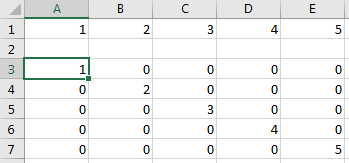Create Diagonal Matrix Using VBA Macro
This example shows how to execute Spreadsheet Link™ functions to export a named range in the worksheet to MATLAB® and create a diagonal matrix using a Microsoft® Excel® VBA macro.
The example assumes that MATLAB is running after Microsoft Excel opens. For details, see Start and Stop Spreadsheet Link and MATLAB.
To work with VBA code in Excel with Spreadsheet Link, you must enable Spreadsheet Link as a reference in the Microsoft Visual Basic® Editor. For details, see Installation.
In a worksheet, enter the numbers 1 through 5 into the
range of cells from A1 through E1.
Define the name testData for this range of cells
and select it. For instructions, see Excel Help and enter the search
term: define and use names in formulas.
The named range testData appears in the Name
Box.

On the Developer tab in Microsoft Excel, click Visual Basic. The Visual Basic Editor window opens.
Insert a new module and create a diagonal matrix from
the data in testData. To insert the module, select Insert > Module. In the Code section, enter this VBA code that contains
a macro named Diagonal.
Sub Diagonal()
MLPutRanges
MLEvalString "b = diag(testData);"
MLGetMatrix "b", "A3"
MatlabRequest
End SubThe Diagonal macro exports the named range
into the MATLAB variable testData using the MLPutRanges function.
Then, the macro uses the MLEvalString function
to execute MATLAB code. The MATLAB code creates a diagonal
matrix from the data in testData using the diag function. The code assigns the diagonal
matrix to the MATLAB variable b. Then, the
macro uses the MLGetMatrix function to import
the diagonal matrix into the worksheet.
Copy and paste the code into the Visual Basic Editor from the HTML version of the documentation.
For details about working with modules, see Excel Help.
Run the macro by clicking Run Sub/UserForm (F5). For details about running macros, see Excel Help.
The diagonal matrix displays in the worksheet cells A3 through E7.

See Also
MLPutRanges | MLEvalString | diag